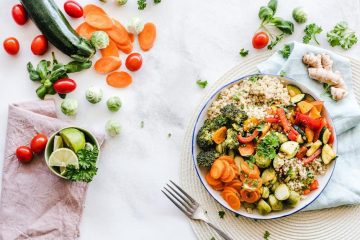Table of Contents
- Smart Shopping Strategies for Cost-Effective Meals
- Creative Meal Planning to Maximize Savings
- Affordable Pantry Staples Every Household Needs
- Tasty and Economical Recipes for Every Meal
- Minimizing Food Waste While Maximizing Budget
- Q&A
- In Summary


Smart Shopping Strategies for Cost-Effective Meals
| Item | Regular Price | Bulk Price | Savings (%) |
|---|---|---|---|
| Rice (per lb) | $0.90 | $0.70 | 22% |
| Dried Beans (per lb) | $1.50 | $1.20 | 20% |
| Oats (per lb) | $1.00 | $0.75 | 25% |


Creative Meal Planning to Maximize Savings
When striving to stretch your grocery budget, infusing creativity into your meal planning can be a game-changer. Start by aligning your weekly meals with what’s on sale or in-season. This not only supports local farmers but also saves you money. Explore bold recipes featuring beans, rice, and seasonal vegetables as these staples are cost-effective and nutritious. Try making hearty soups or stews that stretch ingredients further while delivering comfort on a budget. To keep things dynamic, experiment with different spices and herbs; they can elevate even the simplest dish without adding extra cost.
- Batch Cooking: Dedicate one day to cooking in bulk. Freeze portions for busy days to avoid the temptation of takeout.
- Use Leftovers Wisely: Transform yesterday’s roast into today’s sandwich filling or a vibrant salad topping.
- Repurpose Ingredients: If one recipe calls for half an onion, find another use for the other half to minimize waste.
| Ingredient | Cost-Saving Tips |
|---|---|
| Lentils | Buy in bulk, great for soups and salads. |
| Whole Chicken | Use all parts; make broth from bones. |
| Pasta | Versatile for a variety of budget meals. |


Affordable Pantry Staples Every Household Needs
- Rice: A versatile and economical choice, rice serves as the backbone of countless dishes. Whether you’re making stir-fries, soups, or even desserts, rice adapts to any culinary requirement. Buying in bulk not only saves you money but also ensures you have a long-lasting supply for your meal-prepping needs. Consider brown rice for added nutritional value or switch things up with aromatic jasmine or basmati varieties.
- Beans: Abundant in protein and fiber, beans are a staple that satisfies both your hunger and your wallet. From kidney to black beans, they are ideal for soups, stews, and salads. Canned beans can be convenient for quick meals but buying dry beans in bulk and cooking them at home provides better taste and cost-effectiveness.
- Pasta: Cost-effective and quick to prepare, pasta can transform into a myriad of meals with just a few additional ingredients. Whole grain options offer better nutritional value, and with sauces made from fresh tomatoes or a simple olive oil and garlic dressing, pasta can become a healthy, gourmet meal for any occasion.
| Item | Average Cost per Pound | Storage Tips |
|---|---|---|
| Rice | $0.50 | Store in a cool, dry place in an airtight container. |
| Beans | $1.00 | Keep in a cool, dry place or freeze for longer shelf life. |
| Pasta | $1.20 | Store in original packaging or airtight containers in a pantry. |


Tasty and Economical Recipes for Every Meal
- Breakfast Delights: Start your day with delicious yet affordable meals that set the tone for a productive day. An ideal choice is homemade granola using rolled oats, nuts, and honey, perfect for pairing with yogurt or a splash of milk. For those preferring savory, a simple egg and vegetable scramble offers versatility and nutrition, allowing you to use whatever vegetables are on sale. A sprinkle of cheese can elevate this dish, yet it remains budget-friendly. Essential ingredients for these recipes include oats, eggs, and seasonal vegetables, ensuring both cost and taste stay in check.
- Lunch Ideas: Lunchtime calls for sustenance that doesn’t break the bank. Consider a hearty lentil soup, using carrots, celery, and a hint of cumin for flavor; it’s both filling and easy on the wallet. Another excellent option is a humble vegetable stir-fry, where you can use affordable ingredients like cabbage, bell peppers, and soy sauce. Enhance with protein such as tofu or chicken, often available at competitive prices. Staple items such as these allow for dynamic and tasty lunches without overspending, keeping both your belly and budget satisfied.
-
Dinner Solutions: As evening rolls in, explore the full potential of budget dining. Create a satisfying pasta primavera with spaghetti, garlic, olive oil, and vegetables of choice, ensuring a nutritious feast. Alternatively, a classic chili using beans, tomatoes, and ground beef is not only scrumptious but can stretch to last a few days. Why not round off the day with a potato and leek bake, emphasizing both flavor and thriftiness? Below is a quick table for inspiration:
Recipe Key Ingredients Estimated Cost Pasta Primavera Pasta, Vegetables, Olive Oil $5 Classic Chili Beans, Tomatoes, Ground Beef $8 Potato Leek Bake Potatoes, Leek, Cheese $6


Minimizing Food Waste While Maximizing Budget
In today’s world, aligning our grocery habits with environmental consciousness can create a substantial impact on both the planet and our finances. A strategic way to achieve this involves planning meals around versatile ingredients. By adopting a flexible shopping list, individuals can ensure fewer trips to the market, less impulse buying, and a noticeable reduction in waste. Start by choosing ingredients that can serve multiple purposes. For instance, a bag of spinach can facilitate a nourishing salad, a rich pesto, or even act as a vibrant topping for pizzas. By being resourceful with staple items, we make the most of what’s on hand while saving money along the way.
- Opt for fresh produce that lasts longer like carrots and potatoes.
- Incorporate leftovers into new meals like frittatas or stir-fries.
- Use scraps for homemade stocks or composting.
| Ingredient | Usage Ideas |
|---|---|
| Chicken Breast | Stir-fry, Salad, Sandwiches |
| Tomatoes | Salads, Sauces, Soups |
| Rice | Fried Rice, Porridge, Side Dish |
Maximizing efficiency in the kitchen goes beyond just consumption; it involves smart storage strategies. Consider investing in airtight containers or freezer bags to extend the shelf life of perishables. Additionally, frequent organizing of your pantry and fridge ensures you don’t overlook ingredients, preventing them from spoiling and eventually leading to waste. Keeping an inventory list of what’s available can further enhance cost-effective meal prepping. This approach not only conserves food but also encourages a lifestyle that prioritizes sustainability and frugality naturally.
Q&A
Q: How can I plan meals to stay within my budget and avoid excessive spending?A: Planning is key to staying within your budget while still enjoying delicious meals. Start by creating a weekly meal plan that outlines every meal you intend to prepare. This not only helps in streamlining your grocery list but also prevents impulse buying. Consider incorporating versatile ingredients that can be used in multiple dishes, reducing food waste and costs. Additionally, try cooking in batches and freezing meals for future use, which saves money and time. Remember, sticking to a plan boosts savings and minimizes unnecessary spending.
Q: What are some affordable staple foods that provide good nutrition?A: There are several affordable staples that offer great nutrition while being budget-friendly. Grains like rice, pasta, and oats provide a solid base for many meals and are inexpensive when bought in bulk. Legumes, including lentils and beans, are not only economical but also packed with protein and fiber. Incorporating eggs, canned fish like tuna or sardines, and seasonal vegetables ensures you get necessary nutrients without breaking the bank. These staples can create a wide array of dishes, offering both variety and nutrition.
Q: How can I shop smarter to maximize my food budget?A: Shopping smarter begins before you even reach the store. Always make a list based on your meal plan and stick to it to avoid impulse purchases. Buying in bulk can lead to significant savings, particularly for non-perishable items. Look out for discounts, sales, and generic brands, which often provide great quality at a lower cost. Consider visiting local farmers’ markets, where you can find fresh produce at competitive prices. Lastly, never shop on an empty stomach; it leads to less wastage and keeps your focus on essentials.
Q: Can you suggest some budget-friendly recipes that won’t compromise on taste?A: Absolutely, budget-friendly does not mean sacrificing flavor. Try a hearty vegetable stir-fry that uses whatever veggies are in season or on sale, paired with rice or noodles. A classic bean and lentil soup is not only cost-effective but also rich and nourishing. You can create delicious pasta dishes with simple tomato, garlic, and olive oil sauces that are both affordable and tasty. A frittata made with a mix of eggs and leftover vegetables or meats is another excellent option, perfect for any meal of the day.—Q: What are some tips for reducing food waste and stretching groceries further?A: Reducing food waste starts with thoughtful planning and purchasing. Buy only what you need during your trips to avoid spoilage. Storing food properly, like keeping perishables in the right temperature conditions, extends their life. Consider using leftovers creatively; vegetables can go into soups or stews, while stale bread can be turned into croutons or breadcrumbs. Using the entire fruit or vegetable—such as stems, leaves, and peels—whenever appropriate can add more nutrients and save money. By being mindful, you can stretch groceries further and reduce waste significantly.




0 Comments